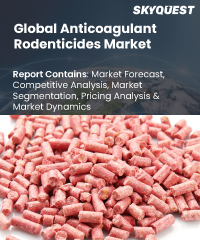
Report ID: SQMIG15C2033

Report ID:
SQMIG15C2033 |
Region:
Global |
Published Date: July, 2024
Pages:
184
|
Tables:
90 |
Figures:
66
Anticoagulant Rodenticides Market size was valued at USD 747.77 Million in 2023 and is poised to grow from USD 773.19 Million in 2024 to USD 1010.3 Million by 2032, growing at a CAGR of 3.40% during the forecast period (2025-2032).
The market is expected to grow as a result of an increase in rodent disease frequency, rodent population expansion, and rodent control demand. Due to the presence of numerous manufacturing firms and the increasing demands from key application industries including such household, pest control, agriculture, and others for products that assist in rodent control, the market is extremely competitive in nature.
Big manufacturers are growing their product lines by creating powders, sprays, and baits with various active ingredient concentrations, including Syngenta Crop Protection AG, BASF SE, and BAYER AG, among others. Anything can be eaten by rodents, including garbage, food scraps, vegetables, plants, grains, seeds, and grass. The majority of rodent diets consist of seeds, while certain species are also carnivorous. In contrast to pellets, powdered, or another form, spraying anticoagulant rodenticides on a surface increases the likelihood that birds and humans are becoming secondary harmed.
These products are used in homes, urban areas, and for agricultural purposes in addition to being used in warehouses and pest control businesses. The market for anticoagulant rodenticides is expected to expand during the forecast period due to the increased demand for rodenticides to control the rodent population. It is anticipated that factors including expanding rat populations, growing demand for rodent control, and the availability of natural rodent control solutions will spur market expansion during the forecast period.
The demand for efficient farming methods and increased agricultural yields using cutting-edge and novel technologies has increased as global concerns about food security grow. More chemicals are being used as a result of application performance rodent methods of control. The development of such products has placed a strong emphasis on how competitive they are with traditional rodent control solutions now available on the market.
US Anticoagulant Rodenticides Market is poised to grow at a sustainable CAGR for the next forecast year.
Our industry expert will work with you to provide you with customized data in a short amount of time.
REQUEST FREE CUSTOMIZATIONWant to customize this report? This report can be personalized according to your needs. Our analysts and industry experts will work directly with you to understand your requirements and provide you with customized data in a short amount of time. We offer $1000 worth of FREE customization at the time of purchase.

Report ID: SQMIG15C2033